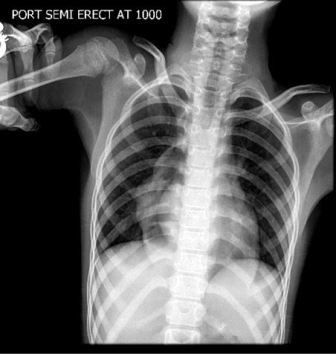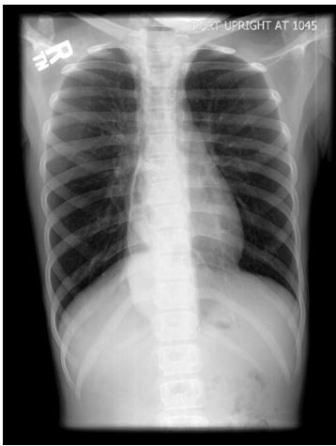- CDC
- Heart Failure
- Cardiovascular Clinical Consult
- Adult Immunization
- Hepatic Disease
- Rare Disorders
- Pediatric Immunization
- Implementing The Topcon Ocular Telehealth Platform
- Weight Management
- Screening
- Monkeypox
- Guidelines
- Men's Health
- Psychiatry
- Allergy
- Nutrition
- Women's Health
- Cardiology
- Substance Use
- Pediatrics
- Kidney Disease
- Genetics
- Complimentary & Alternative Medicine
- Dermatology
- Endocrinology
- Oral Medicine
- Otorhinolaryngologic Diseases
- Pain
- Gastrointestinal Disorders
- Geriatrics
- Infection
- Musculoskeletal Disorders
- Obesity
- Rheumatology
- Technology
- Cancer
- Nephrology
- Anemia
- Neurology
- Pulmonology
Pneumomediastinum or Pseudo-Pneumomediastinum?
Pneumomediastinum is the abnormal presence of air within the mediastinum; causes include blunt force trauma, esophageal rupture, surgical complications.

A 9-year-old girl presented with complaints of recurrent pneumonia. She had a history of transesophageal fistula (TEF) that was diagnosed in utero. Surgery had been performed on the first day of life to correct the TEF; at 18 months, a colonic interposition was performed at an outside facility. The patient had experienced no known postoperative complications other than failure to thrive, a fairly common complication of TEF.
At the time of presentation, the care team was unaware of the patient’s history of colonic interposition. A flexible fiberoptic bronchoscopy was scheduled to further evaluate her bronchial anatomy. Immediately after the bronchoscopy, a chest x-ray film was obtained and a significant pneumomediastinum was observed (Figure 1, left). At this time, the patient’s mother revealed her daughter’s full surgical history, including the previously mentioned colonic interposition. The pneumomediastinum appeared to be the result of air-fluid levels in the mediastinum.
The patient’s pneumomediastinum resolved over the course of about 30 minutes (Figure 2, below), after she was able to eruct. No clinical intervention was needed. Throughout monitoring of the pneumomediastinum, the patient denied chest pain and dyspnea. She remained normoxic. The changes noted with the pneumomediastinum were documented in serial chest radiographs.

Discussion
Pneumomediastinum by definition is the abnormal presence of air within the mediastinum. It is an uncommon condition that generally resolves slowly with conservative management. The causes include blunt force trauma to the chest, spontaneous rupture of the esophagus, foreign-body aspiration, and surgical complications.1
Pseudo-pneumomediastinum, on the other hand, is radiographic evidence of pneumomediastinum that does not follow the expected time course of a pneumomediastinum and is not associated with the expected clinical signs and symptoms, such as chest pain, labored breathing, crepitus associated with the cardiac cycle, and subcutaneous emphysema.
In this report, we describe a case of a pseudo-pneumomediastinum. The decision to classify the patient’s presentation as a pseudo-pneumomediastinum rather than a classic pneumomediastinum was made because the patient did not experience any of the clinical signs of pneumomediastinum and her condition resolved rapidly and spontaneously without the need for additional intervention.
Although cervical leakage is a documented complication of colonic interposition, a literature analysis produced a paucity of published cases of pseudo-pneumomediastinum in a pediatric patient who had undergone colonic interposition.2,3
This case highlights the importance of identifying pseudo-pneumomediastinum to avoid unnecessary, aggressive intervention. We were fortunate to capture the rapid, spontaneous resolution of this patient’s pseudo-pneumomediastinum in consecutive radiographs.
References
1. Singla M, Potocko J, Sanstead J, Pepper P. Ooh-rah! An unusual case of spontaneous pneumomediastinum. Mil Med. 2012;177:1396-1398.
2. Ahmad SA, Sylvester KG, Hebra A, et al. Esophageal replacement using the colon: is it a good choice? J Pediatr Surg. 1996;31:1026-1030.
3. Oida T, Mimatsu K, Kano H, et al. Anterior vs. posterior mediastinal routes in colon interposition after esophagectomy. Hepatogastroenterology. 2012;59:1832-1834.
